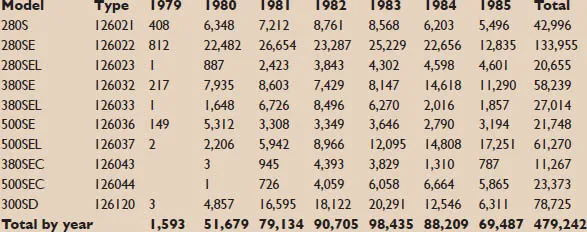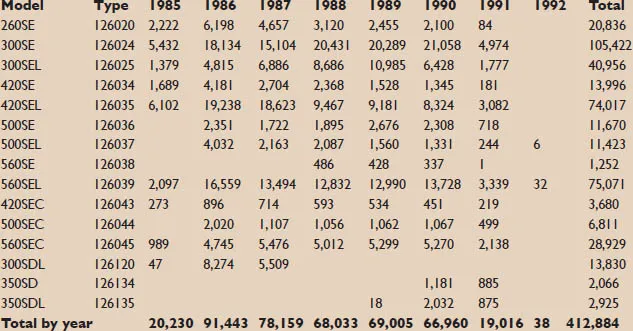![]()
PART I
INTRODUCING THE 126 S-CLASS
Although there have been ‘S’ classifications for Mercedes cars since the early 1950s, the first official flagship Sonderklasse – the German term for ‘special class’ – was officially introduced as late as 1972, with the 116.
The 126 premiered at the Internationale Automobil-Ausstellung (International Motor Show, or IAA) in Frankfurt in September 1979 with an initial line-up of eight models: the 280S, 280SE, 280SEL, 380SE, 380SEL, 500SE and the 500SEL, and a diesel version 300SD for the US/Canada only.
Generally, the term ‘126’ has been used throughout the book, even though the car has become widely known as the W126. For the sake of accuracy, though, it is necessary to distinguish between the models. The standard-wheelbase or ‘SE’ model was so named by abbreviating the German words Sonderklasse Einspritzmotor for petrol-injected engines; ‘SD’ indicated the diesel version. The factory codename of these cars was W126. The long-wheelbase models – the ‘SEL’ (for Sonderklasse Einspritzmotor-Lang) and ‘SDL’ (diesel) – were codenamed V126. In 1981, a two-door sports coupé version C126 (Sport Einspritzmotor-Coupé, or SEC) was premiered at the IAA.
Four years after the introduction of the first generation of 126 models the range was further reworked and presented at the IAA in Frankfurt. There had been visual changes to the bumpers, side covers and alloys, but more significant were the engine variants that were now offered. Two newly constructed six-cylinder engines and two reworked V8s were added, and other engines were further upgraded. The 260 had the new Mercedes M103 2.6-litre straight-six engine and a new 3.0-litre petrol engine was also introduced. The 420 (4.2-litre) replaced the 380 3.8-litre V8 engine. The 500 remained and an upgraded 560 with a sportier 5.6-litre V8 engine joined the family.
The 126 S-Class was replaced by the 140 in 1991, although a satellite factory in South Africa is known to have continued production until late 1992.
PRODUCTION NUMBERS
It is easy to imagine a small-volume manufacturer creating a car that turns into an instant classic but it is more complicated for a mass producer. Thankfully Mercedes Daimler have, for the most part, built models that are considered ‘special’ and, as such, do become sought after, even if they take their time to achieve that reputation. One way to keep ahead of the game is to know the numbers.
Overall, the 126 S-Class achieved a sales total of 892,126 units, made up of 818,066 saloons and 74,060 coupés. The following tables provide a breakdown of total production numbers by the year and model, separating Generation 1 and 2, remembering, of course, that the 500SE, SEL and SEC were the only 126s produced for both generations.
Mercedes Daimler wanted to end production of the 126 in 1988 and introduce the 140 model S-Class at around the same time, but a number of issues – officially described as ‘budget and patent delays’ – led to a two-year extension for the car. It was not until 27 August 1991, after twelve years of production, that the last 126 rolled off the Sindelfingen production line; it was a coupé version with VIN 610819.
The last saloon version, an SEL with VIN 605721, had already rolled off the line four months previously, in the first week of April. It was immediately put aside as a museum piece and remains at the factory museum, occasionally being used as a promotional vehicle.
Mercedes 126 Generation 1
Mercedes 126 Generation 2
MERCEDES 126 SALES POSITIONS
The following table gives the overall sales position and the percentage relating to all 126s sold. It is interesting to note the following:
- The W126 took 55 per cent of the total 126 market, with 490,905 vehicles.
- The V126 took 36.6 per cent of the total 126 market with 327,161 vehicles.
- The C126 took 8.3 per cent of the total 126 market with 74,060 vehicles.
There were a few minor differences to the full production numbers. One noticeable difference was a lack of rounded rub strips on the front and rear bumpers.
Production started with what was known as a ‘pre-production series’ set of vehicles. These were generally test, show, press and showroom models to ‘pre-empt’ full production. They are much sought-after cars among the die-hard 126 fans and quite rare now.
There were a total of 1,590 ‘pre-production’ vehicles built, across the models, as shown in the table above. It is always nice to know where a particular vehicle fits in the model line and with most limited-number manufacturers it is possible to follow model numbers via vehicle identification numbers (VIN). Although this initially applied to the 126, the system changed around the end of 1982/beginning of 1983, making it impossible to know now exactly where each vehicle fits.
The first two years of production saw a model-relevant consecutive VIN system, which equated to the first 281,192 cars. It was relatively simple: all VINs started with WDB126 and model number, then the last six numbers started at 000001 for each model. Once they reached the number listed as the ‘Last VIN’, the numbering system changed so that the numbers increased with all 126 vehicles built, and were not model-related. Following the ‘Last VIN before change’ list, all subsequent 126 vehicles produced followed a total production number thereafter. For example, a 500SEC Cou...



